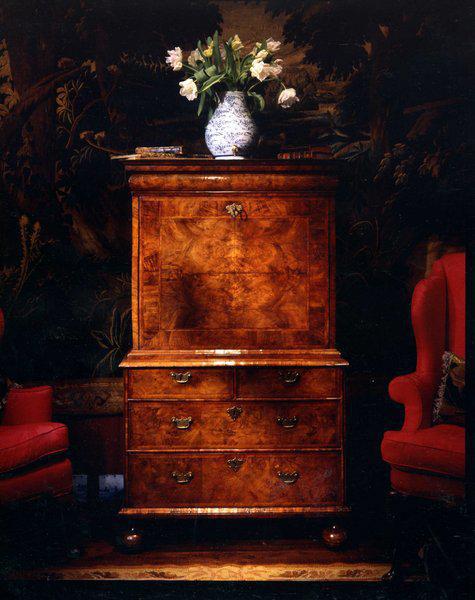An important, petite, late-17th century, walnut-veneered escritoire
10396
The top with a moulded cornice, above a cushion frieze drawer. A single bead moulding above the quarter-cut, feather-banded fall-front with original escutcheon and lock. The upper-interior fitted with pigeon holes with secret drawers behind. A replaced door revealing a central cupboard, with four small drawers, flanked by four drawers with original drop handles retaining traces of their original gilding. A replaced drawer below flanked by two small drawers, and a replaced slide below revealing a secret compartment with two drawers. The flap with a replaced green baize-lined ratcheted writing surface. The lower section with two short and two long, feather-banded drawers faced with single-bead mouldings with original locks and escutcheons, and later period handles. The sides double-cut in straight grain. Standing on replaced bun feet. The carcass oak and pine, the drawers lined in oak.
Minor repairs to veneers. Excellent original colour and patina. Probably English, fourth quarter of the 17th century. 5127968.
This exceptional piece has exquisite, petite proportions, and was probably originally made for the lady of the house. The carpenter, undoubtedly a master craftsman, has both used, and symmetrically-arranged, the finest veneers such as the exceptional quarter-cut, burr on the fall and the grained, veneers on the fitted interior. The condition of this piece is excellent, and the colour and patina have matured to an excellent quality over time.
There was a great increase in letter writing during the Restoration, largely due to the institution of a national postal service, and cabinet makers quickly responded to this by turning their attention to constructing suitable furniture. During the fourth quarter of the 17th century, the incorporation of chains or stays fitted on each side of a large, fall-front enabled it to be supported when lowered as a writing flap. Cabinet makers displayed great ingenuity in the fitting of the interiors revealing series of drawers and pigeon-holes which often concealed secret drawers. During the last decade of the 17th century, the bureau was placed on a chest comprising two short and three long drawers creating increased storage space.
17th Century
1675
Walnut
England
Inherited by the husband of Lady Veronica Bowyer-Smith, a descendant of Sir Thomas Smith of Hill Hall, Theydon Mount, Epping, Essex, in 1951 from the 13th Baronet. By repute, it has been in the family since it was made. It remained at Hill Hall until after the 11th Baronet's death when it passed to the 12th Baronet in 1890 who lived in Tunbridge Wells, and then to the 13th Baronet in 1917/8 who lived in Winchester. After his death it was put into store. The backboards retaining the label of Pitt & Scott Ltd, Golden Acre Depositary. Hill Hall : Hill Hall was one of the most precocious houses of the second half of the 16th century in its use of classical architectural detail. The surviving wall-paintings are the finest of their kind in the country. The site is a scheduled monument, and the main house is listed Grade 1, while the grounds are on the English Heritage Register of Historic Gardens. Although there was a house on the site of Hill Hall dating from the early-13th century, the current building was largely constructed by Sir Thomas Smith who was a classical scholar and notable courtier of Henry VIII, Edward VI and Elizabeth I. He travelled throughout Europe and was influenced by and inspired to reproduce the architecture he saw. The use of classical decoration and, in particular, the two storey columns (a 'giant' order) was exceptional for this period. Smith's desire for ornament and detail extended to the wall paintings dating from about 1570 which are considered to be some of the most important of their period in England. The house remained in the Smith family until early this century, although substantial alterations were made. The east front was rebuilt in English Baroque-style and the interior behind replanned. In the 1730's a fine oak staircase was installed although this was unfortunately destroyed in the fire. In 1791 Humphrey Repton suggested improvements to the grounds and although, these were only partly implemented, Repton's influence is still apparent today. Early this century Hill Hall was let to Mrs Charles Hunter, a well-known society hostess who set about further remodelling of the house just prior to the First World War. Mrs Hunter eventually purchased it from the Smith family in 1923, but was forced to sell in 1925. At that stage it was bought by Sir Robert and Lady Hudson and then by Lord Edward Hay. The gardens were improved during the 1920's under architect Philip Tilden who was responsible for the bathing pavillion and the now lost sunken garden to the east of the house. During the war the house was used as a maternity home and then as a billet for RAF officers. In 1947 the property was acquired for use a women's open prison, opening in 1952. Disaster struck in 1969 when the main block was gutted by fire while the house was in still use as a women's open prison. Eleven years later it was transferred to the Department of the Environment. When English Heritage was created in 1984, they inherited a ruin which was not in a state to be opened to the public or to be returned to beneficial use. Four years ago, English Heritage embarked on a £2 million programme to restore the exterior of Hill Hall, reinstating roofs destroyed in the fire and chimneystacks devastated by the hurricane of October 1987 and conserving the superb Elizabethan wall paintings.
Dictionary of English Furniture (Edwards) figure 29. The Norman Adams Collection, page 94. Cescinsky volume 1, figure 153.











